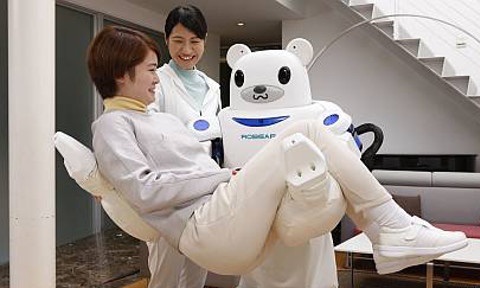A number of companies have explored the idea of humanoid robots as future home-helpers for elderly people. The latest experiment from Japan is distinctly more bear-shaped, though.
Meet Robear, an experimental nursing-care robot developed by the RIKEN-SRK Collaboration Center for Human-Interactive Robot Research and Sumitomo Riko Company.
Unveiled this month, the robot is designed to lift patients out of beds and into wheelchairs, as well as helping those who need assistance to stand up. Robear weighs in at 140kg, and is the successor to heavier robots RIBA and RIBA-II.
“We really hope that this robot will lead to advances in nursing care, relieving the burden on caregivers today,” said Toshiharu Mukai, leader of the project’s robot sensor systems research team.
“We intend to continue with research toward more practical robots capable of providing powerful yet gentle care to elderly people.”
That’s an increasingly urgent challenge in Japan, where the elderly population is growing fast. According to Riken, robots like Robear can play an important role in taking the strain off nurses and caregivers, who may be having to lift patients 40 or more times a day, risking lower-back pain in the process.
Robear remains a research project for now, as Riken and its partners continue to improve the robot’s technology, reduce its weight, and ensure that it will be safe – in this case, through legs that extend while lifting a patient, to ensure Robear does not topple over.
Japan remains the hub for research into humanoid (or, in the case of Robear, at least human-sized) robots, and not just for healthcare.
Mobile operator SoftBank has put its “emotional” Pepper robot to work collecting customer opinions in its stores, with the device also an effective marketing tool. Japan’s biggest bank, Mitsubishi UFJ Financial Group, is also about to start a trial of a customer-service robot called Nao in its stores.
Toyota thrilled and unsettled attendees at the CES show in January in equal measure with its ChihiraAico robot, which resembles a Japanese woman, and is likely to be used to work with elderly people with conditions including dementia, connecting them to medical staff.
guardian.co.uk © Guardian News & Media Limited 2010
Published via the Guardian News Feed plugin for WordPress.








